 Living
in a Fish Camp Living
in a Fish Camp
ELEMENTARY CURRICULUM GUIDE
Grades K - 5
JUNEAU INDIAN STUDIES PROGRAM
City and Borough of Juneau School District
JUNEAU INDIAN STUDIES PROGRAM
10014 Crazy Horse Dr.
Juneau, Alaska 99801
Department of Education
Title IV-A Indian Education Act
Grant #N008500191
*NO portion to be reproduced without
the written consent of the Juneau Indian Studies Program.
FOURTH
GRADE
Due to Alaska environmental resource
diversity, some items can only be found in certain parts of Alaska.
The value placed on such commodities led to the development of a
complicated system of trade among the southeastern island and
mainland Tlingits, and the Athabaskans of the interior of
Alaska.
The fourth grade unit is designed to
develop a greater understanding by students of Alaska's history,
based on this concept. The learner focuses on the "respect" shown our
natural resources, without which we would be unable to survive. Once
a general understanding of respect toward nature is taught, the
students learn more about the items that are traded by the Tlingits
and Athabaskans.
The unit concludes by having a trade game
which enhances the student understanding of the importance of
trade...a time when cultures come together not only to trade, but to
share a mutual respect and appreciation of our natural
resources.
Social Studies Emphasis: Alaska
History
TEACHER INFORMATION
SUMMARY
Unit I: Tlingit
Trading|
Purpose:
Trading is an important means for supplementing one's resources. This
unit allows the student to study and identify items traded by the
Tlingits and the Athabaskans.
The trade game enhances the student's
understanding of trading and expands their knowledge of the
importance of our natural resources.
Day 1 Overview of Alaska's
Cultures
Values:
- Respect for others
- Respect for nature
Knowledge:
- People of Alaska and their
cultures
- Natural resources in southeastern
Alaska--how they are used and respected
- Reading story of Tlingit
Aanee and completing a worksheet
Skills:
- Map skills
- Listening skills
- Reading aloud
- Working independently
Day 2 Respect of Natural
Resources
Values:
- Respect of natural
resources
- Subsistence
- Respect for others'
beliefs
Knowledge:
- The Tlingit ways of catching
salmon and the respect shown toward the salmon
Skills:
- Listening skills
- Reading aloud
- Following directions
- Working independently
Day 3
Living
by the Seasons
Values:
- Respect of natural
resources
- Peace with nature
Knowledge:
- How natural resources are used and
the respect shown toward these resources
- Food gathering times and
procedures
Skills:
- Reading
- Working independently
- Coloring graph
- Identifying specific food
gathering times
Day 4 Putting Natural Resources
to Use
Values:
Knowledge:
- Gathering natural
resources
- Techniques used in making an
article from natural resources
- Demonstration on how to make an
article from natural resources
Skills:
- Listening skills
- Observing
- Participating in
discussion
Day 5 Tlingit and Athabaskan
Trade Items
Values:
- Respect for others
- Sharing
Knowledge:
- Tlingit people are identified by
whether they live on islands or on the mainland
- Three main trading
rivers
- Tlingits traded with one another
and Athabaskans to supplement what they have
Skills:
- Labeling
- Listening skills
- Following directions
- Participation
Day 6 Trade
Items
Values:
- Respect for others
- Sharing
Knowledge:
- Tlingits trade amongst themselves
and with the Athabaskans
- How trading was accomplished and
the types of items traded
Skills:
- Identify three Tlingit Islander
trade items
- Identify three Tlingit Mainlander
trade items
- Identify three Athabaskan trade
items
Day 7 Trade Game
Procedures
Knowledge:
- How trade game will be
played
- How trade cards will be
used
- Describe the setting for our trade
game
Skills:
- Listening skills
- Identify trade items
Day 8 Trade
Cards
Knowledge:
- Identify and draw trade
items
Skills:
- Listening skills
- Following directions
- Drawing
- Coloring
Day 9 Trade Day
Values:
Knowledge:
- Tlingits traded with one another
and with the Athabaskans to obtain a variety of
goods
Skills:
- Listening skills
- Observing
- Participating
Fourth Grade Lesson
Plans
Unit: Tlingit Trading
Lesson: Overview of Alaska's Cultures
Materials:
- 30 large pieces (12"x18") of
construction paper to make "Indian Studies" notebook
- Colored pencils
- Globe of the World
- Large language map of
Alaska*
- 30 small desk maps of Alaska for each
student to label the main Alaskan Native groups
- 30 copies of Lingit Aanee
written by Patricia Partnow
*
Available from the Indian
Studies Office
Objectives:
- Students will be able to orally
define "culture"
- Students will be able to list three
ways that their "Western" way of life is different from the
Tlingit way of life years ago
- Students will be able to name at
least three different Alaskan native groups
- Students will read Lingit
Aanee to obtain information about the natural resources
available in southeast Alaska
- Students will list at least five
natural resources available in southeast Alaska
Introduction
(Set/Purpose)
Begin the introduction the same as for
the Third Graders. Repetition is fine, as the students have more
knowledge after one year and they can add on more information onto
the subject of "culture".
Show the globe of the world to the
students. Explain to them that if they lived here 200 years ago, it
would have been difficult to travel without modern ways of
transportation. There are oceans, mountains, deserts, etc. that are
added obstacles in traveling many years ago. Therefore, people stayed
in their own area and few explored beyond. People rarely saw others
outside of their own "culture" and as a result there was little
outside contact or influence. People's cultures, or way of
life remained intact.
Explain to the students that people all
around the world have many ways that are similar to one another as
well as many ways that are different. Ask the students how we are all
alike and how we are different. As they mention something, write it
on the chalkboard. List about eight items on the board. Some of those
items that students often cover include language, housing, education,
clothing, transportation, entertainment, celebrations, government,
foods, and physical appearance.
Tell the students that culture is a way
of life. It includes everything that they listed on the chalkboard.
Place the word "culture" on the chalkboard. Tell the students that
they may be learning new words. The words that you would like them to
remember will be in the box on the chalkboard.
Tack the Alaska language map up where the
students can see it. Ask them why they are fortunate to live in
Alaska. You may get responses such as, it snows, the beautiful
scenery, etc. Expound on that. "Yes, we are fortunate to live in an
area where there are unique cultures that still exist. There are many
different Alaskan Native groups here in our state and their way of
life is different from each other."
Activity (Instruction and Guided
Practice)
Pass out Alaska desk maps that have not
been labeled with the major Alaskan Native groups. Have the students
refer to their small Alaskan map as the teacher points out where the
major Alaskan Native groups live on the large map. Say each group out
loud and have the students repeat it after you for reinforcement. As
you go over each Alaskan Native group, have the students write that
group on their small Alaska map. Ask the students why there are many
different names for Alaskan Natives. They always respond that each
group has their own unique "culture".
Activity (Instruction and Guided
Practice)
Tell the students that they will make an
Indian Studies notebook. This is where they will place all Indian
Studies handout sheets.
Pass out large construction paper, fold
in half and have the students write their name on the upper right
hand corner. Have them title it Indian Studies and let
them know that their Alaska map should go into this notebook.
(Students tend to lose their papers, so this saves a lot of
time!)
Introduction
(Set/Purpose)
Tell the students that we will be
learning about the Tlingit culture, since we live in southeast
Alaska. An important part of
any culture are the natural resources
available in their area. Write natural resources on the board and ask
for it's definition. We are going to read a book on the natural
resources available in southeast Alaska.
Activity (Instruction and Guided
Practice)
Pass out Lingit Aanee to all of
the students. (This book is an excellent visual resource for the
students to see what natural resources are available in southeast
Alaska). Have each student read one page out loud.
After the students read Lingit
Aanee, discuss. Ask the students if they can name a natural
resource that the Tlingits needed to survive 200 years ago. How would
they have used these natural resources? (A good example to use would
be that blueberries were used for food or dyes). Call on three
students for more examples.
Activity (Instruction and Guided
Practice)
After the students understand that the
natural resources were important to the Tlingits, give them the
handout sheet entitled, Tlingit Natural Resources.
Have the students list some natural
resources that were needed for the Tlingits to survive 200 years ago.
Also, include how these natural resources were used.
Activity (Closure)
Ask the students why the natural
resources were so important to the Tlingits.
Activity (Independent
Practice)
If the students finish their Tlingit
Natural Resource handout sheet, early, they can draw those
natural resources.
LINGIT
AANEE
WRITTEN BY
PATRICIA H.
PARTNOW
ILLUSTRATED BY
JEANETTE BAILEY
The Alaska Bilingual Education Center
Of the Alaska Native Education Board
4510 International Airport Road
Anchorage, Alaska

Imagine standing on a beach
at the shore.

You look out toward the
ocean...
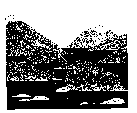
But instead of the ocean,
you see islands-islands right in front of you, and islands off in the
distance.

The islands have tall
mountains on them-mountains with steep sides that come right
down to the shore!

The mountains are covered
with tall, tall trees: spruce, hemlock , and cedar.
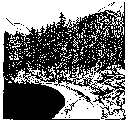
You turn around and look at
the beach you are standing on. The beach is rocky and narrow. Seaweed
clings to the rocks up to the tide line. And right at the edge of the
beach, you see more tall, tall trees.

The ground slopes up and
your eyes follow the shape of the ground-up, up, to the top of
another big mountain right in front of you.
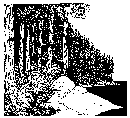
You decide to walk into the
forest. You go to the edge of the rocky beach and look between the
trees.
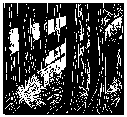
It is dark in there, because
the trees are so tall and thick that they block out all the
sunlight.
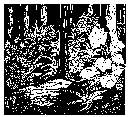
You go in anyway. The ground
feels spongy underfoot. You look down and see moss-soft, wet
moss. And mushrooms. And tall ferns. Blueberry bushes as big as you
are. And a big prickly plant called devil's club that will sting you
if you touch it.
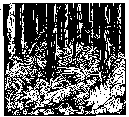
It's hard to walk through
the forest, because there are so many plants, bushes, and fallen
trees in the way. You feel a cool wet breeze on your face and breathe
the wet sweet air. You begin to hear a light pattering noise. You
look up-it's raining a light, drizzly rain.

It becomes more difficult to
walk as the ground slopes up more and more steeply toward the top of
the mountain. You decide to walk back down to the
beach.

It's raining now, and the
clouds are low. You can't see the tops of the mountains on the
islands anymore.

For the first time you
notice the sound of running water. You look around you--and see that
there are lots of streams and waterfalls tumbling down the mountains,
out of the forests onto the beaches, and into the sea.
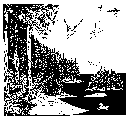
Suddenly you become aware of
noises--animal noises! The islands, forest, ocean, and beaches are
full of animals! You look around in surprise and you
see...
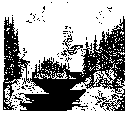
Eagles and ravens and sea
gulls and ducks...Mountain goats and black bears and brown bears and
deer...
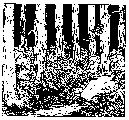
Porcupines and weasels and
squirrels and foxes...

Sea otters and sea lions and
whales and porpoises...
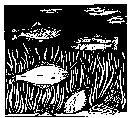
Salmon and halibut and dolly
varden and herring...

And lots
more!!
And you wonder...what kind
of people live in this place?
This is a pre-publication copy being
distributed for purposes of field testing and correction only, not to
be reproduced without the permission of the Alaska Bilingual
Education Center.
Fourth Grade Lesson
Plans
Unit: Tlingit Trading
Lesson: Respect of Natural Resources
Materials:
- 30 copies of The Tlingit Way: How
to Treat Salmon, written by Patricia Partnow*
- 30 copies of the handout sheet
entitled: The Tlingit
- Way: How to Treat
Salmon*
- Lingit Aanee poster by
Patricia Partnow*
- Example of a woosaani or
harpoon*
*
Available from the Indian
Studies Office
Objectives:
- Students will read The Tlingit
Way: How to Treat Salmon to obtain information about how the
Tlingits show respect towards salmon
- Students will understand that the
Tlingits believed that everything has a spirit through reading
The Tlingit Way: How to Treat Salmon
- Students will learn the duties that
the Tlingit women, men and children have at fish camp
- Students will be able to list at
least two different ways that Tlingits caught salmon
Introduction
(Set/Purpose)
Explain to the students that yesterday we
talked about the natural resources available to the Tlingits. The
Tlingits were fortunate to have so many resources available to
them.
Discuss respect for these natural
resources. The Tlingits believed that everything had a spirit. They
showed respect towards all the resources from animals, trees and even
roots from the trees. They knew that they could not survive without
all these resources.
Tell the students that they will be
reading a booklet about how the Tlingits respected salmon.
Activity (Instruction)
Give directions. Tell the students to
read the entire booklet, entitled The Tlingit Way: How to Treat
Salmon. Afterwards, they are to complete the worksheet that goes
along with the booklet.
Activity (Guided
Practice)
Pass out the booklet to each student.
Monitor the students by walking around the room to see how they are
doing. Have the students raise their hands if they need your
help.
Activity (Closure)
After all of the students have completed
their questionnaire, discuss. Go over each question and expound on
it. Ask the students how the Tlingits showed respect towards salmon.
Ask the students where the Tlingits went to during the summer. What
did they do at this place?
Ask the students how the Tlingit men
caught the salmon. It helps to show the poster of Lingit
Aanee. which shows a variety of fishing methods mentioned in
The Tlingit Way: How to Treat Salmon. Also, show an example of
a harpoon or woosaani (in Tlingit). Ask the students what materials
the woosaani is made out of. How does this harpoon catch
salmon?
After discussing the questionnaire,
reinforce to students that it was the Tlingit way to show respect
towards their natural resources. Ask the students why this was
so.
Activity (Independent
Practice)
Students who finish their questionnaire
early can illustrate one Tlingit method of catching
salmon.
THE TLINGIT WAY: HOW
TO TREAT SALMON
Written By:
Patricia H. Partnow
Illustrated By:
Jeanette Bailey
March 1975
A Production of the
Alaska Bilingual Education Center
of the
Alaska Native Education Board
4510 International Airport Road
Anchorage, Alaska

Most Alaskans fish for salmon now and
then, and most people like to eat it. But in the old days, the
Tlingits used to fish for salmon all summer long and into the fall,
and they caught enough to last them through the winter. They ate
salmon for almost every meal.
Since salmon were so important to the
Tlingits, the people wanted to make sure they would catch enough in
the summer and fall to last them through the year. They felt that it
was not enough to have good aim with a salmon harpoon, or to be able
to build a salmon trap just the right size and strength to hold
salmon. They thought those skills were important, but they felt that
skills alone would not catch salmon. They believed that salmon
allowed themselves to be caught only if they wanted to be caught--so
the really good fisherman was the person who knew how to treat fish
well and keep good will between human beings and salmon. Most
important, a good fisherman understood that salmon must not be
insulted or angered--for if the salmon were insulted, they would
never return to the streams where they were born, and the people
would starve.

This story tells some of the special
ways the Tlingits treated salmon, and some of the ways they knew to
avoid insulting the salmon. These were things that all children had
to learn when they were growing up. The children learned by watching
and listening to their parents and uncles and aunts and grandparents,
and they remembered everything that these relatives told them. They
had to--it was a matter of life and death! Then, when the children
grew up, they passed on all these rules, and many more, to their own
children.
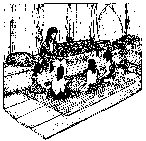
This is the way it used to
be:

In the summer, all the clans headed
for fish camp, each clan going to the fishing grounds and stream that
it owned. A clan often owned more than one good salmon stream, so the
members of the clan would split up. Some men took their families to
one stream, others took their families to another
stream.
Once a group of clansmen and their
families arrived at fish camp and had set up tents and arranged their
belongings, they helped each other build salmon traps and weirs and
put up nets across the openings of streams. Then they all fished
together, but each man kept the fish he caught for his own family.
And each woman cleaned and dried the fish her husband caught for
their family.
That is the way it used to be: the
family needed the man to catch the fish; and it needed the woman to
prepare the fish.
Catching Salmon
In the old days, only the men caught
salmon. Women were not allowed to come close to the water when salmon
were running. This was one way people showed respect for
salmon.
The men knew lots of different ways to
catch salmon. Here are some of them:
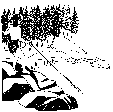
If the men were fishing in a clear
stream or river, they might build a barricade of sticks (called a
weir) across the stream to keep the salmon from swimming upstream.
They stood on the banks of the river and threw a long spear called a
harpoon to catch the salmon.
The harpoon head was made of bone. It
rested in a notch at the end of the wooded spear handle. A rope made
of spruce roots or kelp was tied to the harpoon head at one end and
to the handle at the other.

When a salmon was harpooned, the
fisherman held on

to the rope. The harpoon head came
loose from the handle, and stuck in the salmon. The fisherman let the
salmon swim around on the end of the rope, and when it became tired,
the man pulled the fish to shore.
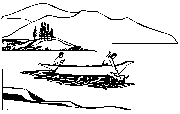
If the men were fishing in a silty
glacial stream and couldn't see anything in the water, they used a
long gaff hook to catch the salmon.

The handle of the gaff hook was made
of a straight stick, and the hook was made of sharpened
bone.

Sometimes, the men used large dipnets
for catching salmon.

In the streams with heavy salmon runs,
the fishermen used large fish traps for catching the salmon. They
would catch more salmon this way than any other.
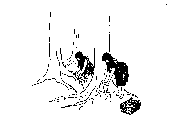
The traps were made of pieces of wood
which were lashed together by spruce roots. The men collected the
wood, and the women gathered the spruce roots.

The men built the trap. Then they
placed it across the stream with the opening facing
downstream.

As the salmon swam upstream to their
spawning grounds, they were guided to the opening of the trap. They
swam into it, but could not find their way out.

When the trap was full, it was hauled
out of the water and the salmon were taken to the women to
clean.
After a man caught a salmon, he sang
to it, explaining why he had killed it. The song might say something
like this:
"Why did I kill that fish?
I need it to eat.
My family at home is hungry- -
I didn't kill it for nothing.
Forgive me."
Preparing Salmon
The women liked to be together when
they were cleaning and smoking salmon. They stayed close to the
campsite, and talked and laughed as they worked. They had to work
quickly to clean the fish before they spoiled. The children helped
them--some helped to clean fish, others helped by babysitting for
their younger brothers and sisters.
Each woman had a large cutting board
made of cedar or spruce wood for cleaning the fish. She put this on
the ground, and put the fish she was going to clean on the board with
its head pointed upstream. The fish's head always had to point
upstream, for at the head of the stream it would spawn, and its soul
would be born again in the body of another fish. The woman herself
sat on the ground facing downstream, with her side, not her face,
towards the water.
To clean the fish, the woman would cut
off its head and make a cut down the fish's belly to clean the guts
out. Then she cut the fish almost in two along the backbone and
pulled the backbone and ribs out. She cut slits in a special pattern
in the meat. Each woman cut her own special design in the fish for
her family. That way, she could tell which fish were hers after they
were dried along with everyone else's salmon in the big
smokehouse.

She saved the fish eggs to dry or
smoke.

The women were very careful to take
care of the bones, head and guts of the salmon. In some parts of
Lingit Aanee, the women burned all of the left-over parts of the
salmon after they cleaned it. In other areas, they threw them into
the stream. This was one of the things which the salmon demanded of
human beings. Otherwise, the fish would not be reborn and the people
would starve.

There was usually one big smokehouse
at summer fish camp. Sometimes people lived in the smokehouse, and
other times they lived in tents or small huts and only used the
smokehouse for drying fish.

The door of the smokehouse faced the
river or stream. Sticks to hold the drying salmon hung across the
house, in the same direction as the river. When a woman put her
salmon on these sticks, she made sure that the front end of the
salmon was heading upstream.
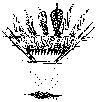
The fire for smoking the fish was made
of alder wood and cotton wood. It was not allowed to get too hot,
because then the fish would cook and the meat would fall off the
skins into the fire. Every night the fire was smothered, and every
morning it was started again.

The women had to pay close attention
to the salmon they were smoking. The fish had to be moved around so
they would not spoil, and had to be checked to see if they were
drying evenly all the way through.
After about a week the smoking would
be finished, and the women would take their fish down from the
sticks.
They stacked the dried fish together,
packed them all between two boards, and put them in a wooden box. The
fish were stored in the box until later in the year when the family
was ready to eat them.
And that's the way it used to
be!
This is a pre-publication copy being
distributed for purposes of field testing and correction only, not to
be reproduced without the permission of the Alaska Bilingual
Education Center. 3-75-500.
Name:_________________________________
The Tlingit Way: How to Treat
Salmon
Please answer the following
questions:
1. According to the Tlingit people, the
really good fisherman was the person who knew how
to:___________________________________________________________________
2. Why did a good Tlingit fisherman feel
that salmon should not be angered or insulted?
___________________________________________________________
3. How did the Tlingit children learn
since they did not have books to
read?______________________________________________________________________
4. Where did the Tlingit people go during
the summer
months?______________________________________________________________________
5. What did the men do at the place in
the
summer?_____________________________________________________________________
What did the women do at the place in the
summer?______________________________________________________________________
6. Did the women help the men catch the
salmon? Why or why
not?______________________________________________________________________
7. The men knew many different ways to
catch salmon. Name and describe these different ways of catching
salmon.______________________________________________________________________
8. What was the harpoon head made out
of?______________________________________________________________________
9. Which method of fishing caught the
most fish for the Tlingit
people?
________________________________________________________
10. Why did the Tlingit men sing to the
salmon after it was caught?
____________________________________________________
11. How did the Tlingit children help
their parents at the fish
camp?______________________________________________________________________
12. The women placed the salmon on a
cutting board to clean. The head of the salmon pointed upstream as it
was being cleaned.
Why?______________________________________________________________________
13. Each woman cut her own special design
in the fish for her family. Why did she do
this?______________________________________________________________________
14. The fire for smoking the fish was
made of:
a.___________________________________
b.___________________________________
15. What would happen to the salmon if
the fire for smoking the fish was too
hot?______________________________________________________________________
16. What type of containers were the fish
stored
in?______________________________________________________________________
Juneau Indian Studies
Fourth Grade Lesson
Plans
Unit: Tlingit Trading
Lesson: Living by the Seasons
Materials:
- 30 copies of the handout sheet
entitled, Tlingit Economic Year
- 30 copies of the Tlingit
Economic Year questionnaire
- A copy of page 115 from the book,
Cedar, by Hilary Stewart
- An item made from cedar bark (i.e.,
cedar bark basket, hat, etc.)*
- Cedar bark*
* Available from the Indian Studies
Office
Objectives:
- Students will learn when Tlingits
gathered their natural resources after coloring the pie graph
provided in Indian Studies curriculum
- Students will explore how certain
natural resources were gathered (i.e., cedar bark)
- Students will listen to the
instructor talk about the importance of respect towards their
natural resources (i.e., cedar bark)
Introduction
(Set/Purpose)
Yesterday we discussed how and why the
Tlingits showed respect toward salmon. Today we will learn the time
of the year that Tlingits gathered their natural resources. Talk
about the seasons and what was gathered and utilized during those
periods.
We will also be studying about one of the
natural resources cedar bark. We'll find out how the cedar bark was
gathered and how they showed their respect toward the tree for the
use of
bark.
Activity (Instruction)
Provide each student with the pie graph
entitled, Tlingit Economic Year and the questionnaire that
goes along with it. Students are to color the calendar according to
the directions. After coloring the pie graph, they are to answer the
questionnaire that goes along with it.
Activity (Guided
Practice)
Students will color the Tlingit
Economic Year pie graph and answer the questionnaire. Monitor the
activity by walking around the room, having students raise their hand
if they need assistance.
Activity (Independent
Practice)
If students finish their questionnaire
early, have them draw a picture to go along with their written
description of what natural resources they would have gathered during
the month of May.
Activity (Closure)
After students complete their
questionnaire, discuss as a group and have students give their
answers. After the students finish coloring the pie graph, they seem
to have a better concept of when different resources were
gathered.
Activity (Instruction and Guided
Practice)
Remind the students that the Tlingits
respected all of their natural resources. They never wasted anything.
They believed that if they treated these resources with respect, then
there would always be a supply of resources to continue their
survival. They were in harmony with nature.
Use cedar bark as an example of how the
Tlingits gathered their resources. Show the students how the bark was
gathered. Refer to page 115 from the book, Cedar, by Hilary
Stewart. Show samples of what the Tlingits made out of cedar bark
(i.e., cedar bark hat, clothing, baskets, etc.)
Activity (Closure)
Reinforce to the students that the
Tlingits could not have survived without the help of their natural
resources. They knew this and respected their environment. They
showed their respect in a variety of ways. For instance, if they were
using the bark from the tree, they would thank the tree.
Do you remember from yesterday, how the
Tlingits showed their respect toward salmon? How is this similar to
showing respect toward the tree?
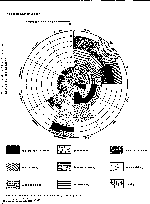
Click to
see bigger image
Name:_________________________
The Tlingit Economic
Year
- Color the bark gathering
BROWN
- Color the deep sea fishing
BLUE
- Color the berry picking
GREEN
- Color the seaweed gathering
YELLOW
- Color the salmon fishing
RED
- Color the hunting
ORANGE
Directions: Refer to the Tlingit
Economic Year graph to answer the following questions:
1. The Tlingits gathered bark during the
month of?___________________________________
2. What is today's
date?___________________________________
What would the Tlingits be going
during this month?___________________________________
3. Which month did the Tlingits spend a
lot of their time fishing for
salmon?___________________________________
4. Which months look like the busiest
months for the Tlingit
people?___________________________________
5. If you were a Tlingit in the
year 1885, describe in your own words what life would have been like
for you during the month of
May.___________________________________
Juneau Indian
Studies
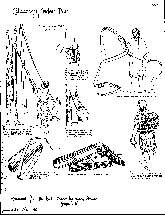
Click to
see bigger image
Fourth Grade Lesson
Plans
Unit: Tlingit Trading
Lesson: Putting Natural Resources to Use
Materials:
- A Tlingit resource person to
demonstrate how to make an article from their natural resources.
(i.e., Chilkat Blanket Weaver, Spruce Root and Cedar Bark Basket
Maker, etc.)
- Materials necessary for the resource
person (i.e., a table for demonstration, slide projector,
etc.)
Objectives:
- Students will observe a Tlingit
resource person demonstrate how they make an article from the
natural resources
- Students will recognize the amount of
work it takes to gather and prepare the natural resources to make
an article
- Students will recognize the amount of
work it takes to make an article
- Students will observe how the
resource person shows their respect toward natural resources
and/or their working materials
Introduction
(Set/Purpose)
Introduce the Tlingit resource person.
Inform the students that we are fortunate to have this person share
their knowledge. This person will be your teacher for the next 40
minutes.
Tell the students that after our guest
demonstrates we will be discussing how the natural resources were
gathered and prepared before making an item. How does this person
show respect toward the natural resource?
Activity (Instruction and Guided
Practice)
Students will observe a demonstration
from a Tlingit resource person. During this demonstration, students
will recognize the vast amount of work it takes to gather and prepare
the supplies needed and then finally produce a finished
product.
Activity (Closure)
Thank toe native resource person for
sharing with the class. Have the students ask questions. Discuss the
demonstration.
Fourth Grade Lesson
Plans
Unit: Tlingit Trading
Lesson: Tlingit/Athabaskan Trade Items
Materials:
- 30 copies of student desk map showing
southeast Alaska trade routes
- Large map of Alaska's Native
People*
- Colored pencils for each
student
- Examples of Tlingit and Athabaskan
trade items (i.e., artifacts, photographs, etc.)*
- For references on Tlingit trading,
refer to Under Mount St. Elias, by Frederica deLaguna,
The Social Economy of the Tlingit Indians, by Oberg and the
teacher guide, Tlingit Trade Game, by Patricia
Partnow*
*
Available from the Indian
Studies Office
Objectives:
- Students will be able to
differentiate between the Tlingit villages located on islands and
the Tlingit villages located on the mainland by labeling a map of
southeast Alaska
- Students will identify the major
rivers used for trading by labeling the southeast Alaska
map
- Students will participate in a
discussion on trading
Introduction
(Set/Purpose)
Explain to the students that the Tlingits
had villages located in two different areas. Some Tlingits lived on
the islands. (Define island for those who may not know what it is).
Some Tlingit villages are located on the mainland near large
rivers.
Activity (Instruction)
On the large Alaska map, point out the
difference between the Tlingit islands and mainland. Tell the
students that they will be given their own map of southeast Alaska.
On this map, the students will see the names for several Tlingit
villages.
List the Tlingit villages (Island and
Mainland) onto the chalkboard. For example:
|
Mainland
Villages
|
Island
Villages
|
|
Chilkat
|
Hoonah
|
|
Yakutat
|
Henya
|
|
Tongass
|
Angoon
|
|
Auke
|
Sitka
|
|
Chilkoot
|
Kake
|
|
Stikine
|
Kuiu
|
Also, list on the chalkboard, a few of
the major Tlingit rivers.
Examples are: the Stikine River, the Taku
River and the Alsek. Add the Copper River to the list. It is an
Athabaskan River.
Give each student their own map of
southeast Alaska. Ask them to circle the mainland villages with a
brown pencil, the island villages with a green pencil and the rivers
with a blue pencil.
Activity (Guided
Practice)
Students will identify the Tlingit
villages located on the mainland and islands by circling these
villages on the southeast Alaska map. They will also locate the major
rivers listed above.
Monitor this activity by walking around
the room. If the students need further assistance, have them raise
their hand.
Once the students have finished circling
the Tlingit villages and rivers, go over to the large Alaska map and
point out where all the villages and rivers are. If they have made a
mistake, have them correct it.
Activity (Instruction and Guided
Practice)
When the students understand that the
Tlingit villages are located on the islands and the mainland,
introduce the concept of trading. Why do people trade? Why do you
think the Tlingits traded? Who did they trade with?
Activity (Closure)
Review briefly the material that was
covered for the day. What is the difference between the villages
located on the island as opposed to those located on the mainland?
What are the names of some of the Tlingit villages? Are they located
on islands or on the mainland? What are the names of a few of the
major Tlingit rivers?
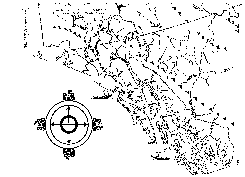
Click to see bigger image
Fourth Grade Lesson
Plans
Unit: Tlingit Trading
Lesson: Trade Items
Materials:
- Examples of Tlingit and Athabaskan
trade items (i.e., artifacts, photographs, etc.)
- Variety of natural resources that the
trade items were made from. Examples: cedar bark, spruce roots,
moose-hide, mountain goat wool, etc.)
- 30 copies of Harvest Time at the
Beach handout sheet*
- 30 copies of the handout sheets
entitled: Plant Foods, Beach Foods, Berries and
Animal Foods*
- Cedar, written by Hilary
Stewart. Refer to pages 115 and 172
- Kahtahah, written by Frances
Lackey Paul. Refer to pages 12 and 13
*
Available from the Juneau
Indian Studies Program
Objectives:
- Students will be able to identify
three items that were traded by the Tlingits from the
islands
- Students will be able to identify
three items that were traded by the Tlingits from the
mainland
- Students will be able to identify
three items that the Athabaskans traded with the
Tlingits
- Students will observe the natural
resources needed to make the trade items
- Students will be able to identify the
items that these three groups of people would like in
return
Introduction
(Set/Purpose)
Review yesterday's lesson on trading.. Do
the students understand the concept of trading? Reinforce that the
Tlingits traded to obtain a variety of goods. We will go over these
goods that the Tlingit people traded between themselves and the
Athabaskans.
Activity (Instruction and Guided
Practice)
The Tlingits that lived on the islands
were surrounded by water. These people had plenty of seafood, shells
and they had cedar trees, green stone, etc. Bring samples or handouts
of the items that the island Tlingits had.
These Tlingits that lived on the islands
traded the above goods with Tlingits from the mainland. In exchange,
the mainland Tlingits would have items like eulachon oil, cranberries
in oil, mountain goat horn spoon, Chilkat blankets, etc. Bring
samples of these goods to show the students.
The mainland Tlingits traded also with
the Athabaskans. The Tlingits wanted different Athabaskan items such
as moosehides, copper, birchwood bows, caribou hides and wolf moss.
Explain why these items were desired by the Tlingits.
In return, the Athabaskans wanted Tlingit
items such as iron, cedar bark baskets, shell ornaments, cranberries
in oil and eulachon oil.
It is easier for the students to remember
which group of people owns what if you have three display tables.
Each table should represent the goods from each group of people
(i.e., the island Tlingit, mainland Tlingit and Athabaskan). Write on
the board or posterboard the three groups of people and underneath
list the items that these people had. Below this list, add the goods
that each of these groups desired. (Refer to the lesson on Trade
Procedures for a listing of these items).
Activity (Closure)
Review the extensive material covered for
the day. Ask the students to list all three groups of people. Below
that list, briefly copy the information from the board. Save this
list for future reference.
 Spring
Eulachon Camp Spring
Eulachon Camp
Reprinted from the book, Kahtahah,
by Frances Lackey Paul, (pages 12-13).
One day as they were watching a big
eagle swooping to the water for a fish, Kahtahah told her foster
mother that she liked the summer camp best of all the places that
they lived. "All winter it is dark and cold and rainy," she said.
"Then spring comes and we go up the Stikine to the eulachon camp, but
it is still cold. In summer camp there are no grizzly bears to be
afraid of and there are so many different things to do, so summer
camp is much the nicest."
The eulachon camp was where Snook's
family always stopped for two or three weeks in the spring on the way
up the Stikine to hunt grizzly bears and to gather spruce roots.
There they fished for eulachon, a sort of needlefish smaller than a
herring, commonly called hooligan. These fish came into the big
rivers to spawn by the millions, sometimes before the ice was gone.
Then the men had to set their nets of woven spruce roots through
holes in the ice, but the nets were often carried away if the
eulachon run came after the breakup of the ice and the big blocks of
ice rushed down the river, sweeping everything before them. The men
who went out in canoes to dip up the fish in their baglike nets were
in danger, too. Only the spring before, one of the slaves had drowned
when a cake of ice upset his canoe.

The Indians knew when a fish run was
coming because great flocks of sea gulls followed the eulachon up the
river, flying about, screaming, diving, swimming and fighting as they
fed on the eulachon all day long. The women strung hundreds of the
little fish on bark ropes, hanging them in the sun and the wind to
dry, sometimes with a slow smoking fire under them.
The fish were so rich in oil that it
dripped out while drying. But the most important part of eulachon
fishing was trying out the oil, which was done in several steps.
First, the fish were heaped in large piles until they were partially
spoiled, which separated the oil more quickly. The fish were then put
in canoes or big boxes, and water and hot rocks added. The water was
kept boiling with additional rocks until all the oil from the fish
had risen to the top. When cool, the thick grease was skimmed off and
stored in wooden boxes.

When the eulachon run was large all
the Indians filled many boxes with grease. The Tlingits liked to use
the oil themselves for dipping dried halibut and salmon and as a
sauce for boiled salmon eggs, but they also traded it to Indians who
did not own a spring camp on the Stikine. Good eulachon fishing
grounds made rich Indians because others traveled long distances just
to buy the oil.
Fourth Grade Lesson
Plans
Unit: Tlingit Trading
Lesson: Trade Game Procedures
Materials:
- Resources on Tlingit Trading:
- Under Mount St. Elias by
Frederica deLaguna*
- The Social Economy of the
Tlingit Indians by Oberg*
- The Tlingit Trade Game, a
teachers guide, by Partnow*
- Trade cards representing items from
the island Tlingits, mainland Tlingits and the
Athabaskans
*
Available from the Indian
Studies Office
Objectives:
- Students will observe the rules to
the Tlingit trade game in which they will participate in during
the next few days
- The class will practice playing the
trade game with the instructor
Introduction
(Set/Purpose)
Begin with a review from yesterday's
lesson. Ask the students what items were traded by the Tlingits from
the islands, the Tlingits from the mainland and the Athabaskans. What
items did these three groups of people want in return?
Explain to the students that certain
trade routes were owned by different clans. The Tlingits that lived
on the mainland near the large rivers had the advantage for trading
with the Tlingits from the islands and the Athabaskans. (Refer to the
resources listed under Materials). The mainland Tlingits acted
as a middleman in trading between the island Tlingits and the
Athabaskans. If the Athabaskans wanted a product from the island
Tlingits, they would have to go through the mainland Tlingits. If the
island Tlingits wanted an Athabaskan product, they, too, would have
to go through the middleman, the mainland Tlingits.
When the Tlingits traded, they had a
trade partner. (Refer to Under Mount St. Elias by
deLaguna)
Explain to the students that they will be
involved in a Tlingit Trade Game in a few days. The instructor will
be going over the rules to this trade game.
Ideally there should be three classes
involved in the game. One class (Fourth Graders) would represent the
mainland Tlingits.
Another class (also Fourth Graders) would
represent the island Tlingits and the Athabaskans would be
represented by yet another class (Fifth Graders).
Activity (Instruction and Guided
Practice)
Explain to the students that before the
trade game begins, the instructor will decorate a classroom. It
should look like the mainland Tlingits have traveled a distance and
have set up a camp. This will be where the mainlanders will trade
with the islanders and Athabaskans.
The mainlanders will stay in this trading
area during the entire game. Remember, the mainlanders are the
"middlemen" between the islanders and the Athabaskans.
Then, the Athabaskans will pretend like
they've hiked a great distance to trade with the mainlanders. The
Athabaskans will be greeted by the mainlanders. To determine your
partner, the mainlanders will be in a single line. The first
Athabaskan in line will be the partner of the first mainlander, and
so on. (This will prevent confusion). The students must remember who
their partner is, because they will be trading together twice during
this trading game.
The mainlander will take their Athabaskan
trade partner back to their tent or around the fake fire pit to begin
trading.
This is a description of how the trading
game will take place...
Each group (the mainland Tlingits, island
Tlingits and Athabaskans) will have trade cards representing their
trade goods. Put on the chalkboard or posterboard, a list of what
each group of people will have to trade at the beginning of the game
and a list of items that they will want by the end of the trade
game.
Tlingit Islanders
At the beginning of the game, the
islanders WILL TRADE the following items:
- 2 Cedar Bark Baskets*
- 2 Irons*
- 2 Shell Ornaments*
- 1 Seal Oil
Tlingit Islanders
At the end of the game, the islanders
WILL WANT the follow-items:
- 1 Moosehide (Athabaskan)
- 1 Copper (Athabaskan)
- 1 Birchwood Bow
(Athabaskan)
- 1 Mountain Goat Horn Spoon (Mainland
Tlingit)
- 1 Chilkat Blanket (Mainland
Tlingit)
Tlingit Mainlanders
At the beginning of the game, the
mainlanders WILL TRADE the following items:
- 1 Eulachon Oil
- 1 Cranberries in Oil
- 1 Mountain Goat Horn
Spoon
- 1 Chilkat Blanket
Tlingit Mainlanders
At the end of the game, the mainlanders
WILL WANT the following items:
- 1 Moosehide (Athabaskan)
- 1 Copper (Athabaskan)
- 1 Birchwood Bow
(Athabaskan)
- 1 Caribou Hide
(Athabaskan)
- 1 Wolf Moss (Athabaskan)
- 1 Iron (Tlingit
Islanders)
- 1 Shell Ornament (Tlingit
(Islanders)
- 1 Cedar Bark Basket (Tlingit
Islanders)
- 1 Seal Oil (Tlingit
Islanders)
Athabaskans
At the beginning of the game, the
Athabaskans WILL TRADE the following items:
- 2 Moosehides*
- 2 Coppers*
- 2 Birchwood Bows*
- 1 Caribou Hide
- 1 Wolf Moss
Athabaskans
At the end of the game, the Athabaskans
WILL WANT the following items:
- 1 Iron (Tlingit
Islanders)
- 1 Cedar Bark Basket (Tlingit
Islanders)
- 1 Shell Ornament (Tlingit
Islanders)
- 1 Cranberries in Oil (Mainland
Tlingit)
- 1 Eulachon Oil (Mainland
Tlingit)
*
Indicate two for one trade items
for the Mainland Tlingit
Remember, the Mainland Tlingits are the
middlemen. Mainlanders, because of their intermediate position,
extract a commission from each trade, thereby becoming quite rich in
items.
If either the Athabaskans or the
islanders want to trade an item that both other groups of people
would like (for example, the Athabaskans want to trade copper and
both the mainlanders and the islanders want copper), then the
mainlanders will only give them one item for two.
The Two-for-One items are:
|
Tlingit
Islanders
|
Athabaskans
|
|
Cedar Bark Baskets*
|
Birchwood Bows*
|
|
Shell Ornaments*
|
Copper*
|
|
Iron*
|
Moosehide*
|
If the Athabaskans want to trade copper,
the mainlanders will give the Athabaskans one item (for example,
cranberries in oil) for 2 coppers. Then the mainlanders are able to
trade one of the coppers to the islanders.
(*) The asterisk indicates
two-for-one trade items for the mainlanders.
The object of the game is to trade the
abundant items for the needed or wanted items from the other groups
of people.
Once the Athabaskans have traded with the
mainlanders for about 5 minutes, the Athabaskans will leave the
trading room. After the Athabaskans have left the room, the
mainlanders will stand in a line waiting for the islanders to arrive.
The islanders will pretend that they have canoed a great distance to
trade. Establish trade partners. (This will be done the same way that
trade partners were established for the Athabaskans).
The mainlanders will then take their
islander trade partner back to their tent or around the tent to
trade. Trading will take place for 5 minutes. After 5 minutes of
trading, the islanders will leave the room.
The Athabaskans will come back to the
trading area and go back to their same trading partner. They will
trade with the mainlanders for 5 minutes. (This will be the second
time that the mainlanders and Athabaskans have traded). Why is this?
The Athabaskans come back to trade for the second time so that they
can get the islander items that the mainlanders have now. After the
Athabaskans have traded for 5 minutes, they will leave the
room.
The islanders will come back for their
second time of trading with the mainlanders. They will trade for 5
minutes with the same mainlander trade partner in hope of getting
some Athabaskan trade items.
Activity (Closure)
After all students have traded, get the
three groups together to discuss the trade game. What did they learn?
Sometimes, the students find it unfair that the mainlanders come out
with more of a variety of items.
Tell the students that the islanders and
the Athabaskans were also the middlemen with other groups surrounding
them.
The students also need to know that we do
not know the authentic exchange rate of trade items. This trade game
is not accurate with the rates of exchange, but the students do get a
feel of what trading is all about. They learn what natural resources
were available to trade and the items that they would like in
return.
Teacher Note:
The cards following this lesson must be
duplicated and cut out before handing out to students.
Fourth Grade Lesson
Plans
Unit: Tlingit Trading
Lesson: Trade Cards
Materials:
- White paper to draw trade
items
- Colored pencils, markers or
crayons
- Resource books on Alaska animals,
Alaska native clothing, pictures of cedar trees, bark, Tlingit sea
life, etc.*
- Samples of trade items. (Shells,
cedar bark, mountain goat horn spoons, spruce root baskets, iron,
photographs of a Chilkat blanket, etc.)*
- Examples of trade cards
(Tlingit)
*
Available from the Indian
Studies Office
Objectives:
- Students will draw trade cards to use
for the trade game
Introduction
(Set/Purpose)
Tell the students that we will be having
our trade game tomorrow. We will need to make our own trade cards to
play the game.
Activity (Instruction)
Place resource books, samples of trade
items, white paper for drawing and colored pencils on a
table.
Show the students an example of how they
can make their own trade cards. If they are representing the island
Tlingits, they will need to make trade cards of the following: 1 Seal
Oil card, 2 Cedar Bark Basket cards, 2 Iron cards and 2 Shell
Ornament cards. If they are representing the mainland Tlingits, they
will need to make trade cards of the following: 1 Eulachon Oil card,
1 Cranberries in Oil card, 1 Mountain Goat Horn Spoon card, and 1
Chilkat Blanket card.
The students can refer to the table of
resources if they need a picture of what their trade items look like.
Also, some students will need paper and colored pencils.
Activity (Guided
Practice)
Monitor the activity by walking around
the classroom. If students are having problems getting started, refer
them to the resource table. For those students that need additional
help, have them raise their hand.
Activity (Independent
Practice)
Students that may finish early can help
the instructor assist with those students that many need extra help.
They can also draw other trade items to keep for
themselves.
Activity (Closure)
Have the students write their name and
teacher's name on the back of their trade cards. Remind them to write
the group that they are representing, and the name of the trade item
onto their trade cards. If they are representing an island Tlingit,
they will need a star on the upper right hand corner for the
following items: cedar bark baskets, iron and shell
ornaments.
Fourth Grade Lesson
Plans
Unit: Tlingit Trading
Lesson: Trade Day
Materials:
- 3 fish camp tents (refer to trading
area handout)
- Fake rocks, firepit and fish roasting
over firepit*
- Fake blueberry bushes, skunk cabbage,
devil's club, etc.*
- Furs, bentwood boxes, mountain goat
spoons, etc., to place in or around tents*
- Button blankets for students
representing mainland Tlingits
- Shells, cedar bark, etc., for the
students representing the island Tlingits*
- Hides, bows and arrows, etc., for the
students representing the Athabaskans*
- 30 copies of "want list"
- a
list of goods (or cards) that students should have by the end of
the trade game
*
Available from the Indian
Studies Office
Objectives:
- Students will participate in a
Tlingit trade game
- Students will trade cards
representing trade items with their trade partner
- Students will observe that the
Tlingits traded with each other and with the Athabaskans to obtain
a variety of goods
- Students will observe that the
mainland Tlingits were the "middlemen" between the island Tlingits
and the Athabaskans
Introduction
(Set/Purpose)
The instructor or instructors will need
to speak to each class representing the different groups (i.e.,
island Tlingit, mainland Tlingit and Athabaskan). Each class will
need to be briefed on the rules to the trade game.
One of the classrooms should be decorated
to look like the outdoors. This should be done in advance before the
trade game begins.
The mainland Tlingits will stay in the
decorated room throughout the trade game. The island Tlingits and
Athabaskans will be coming in and out of this room twice to trade
with the mainlanders.
Refer to the lesson in Trade Game
Procedures for instructions on how the Trade Game should be
played.
It is necessary to let the students know
when their 5 minutes is up for trading, because the Athabaskans will
leave the trading area to allow for the islanders to trade. The
students will need a cue that won't distract them so they will know
when it is time to leave the room. One suggestion is to leave the
lights out (using natural lighting) during the trading. When 5
minutes is up, quickly flick the lights on as a cue to
leave.
Provide the mainlanders with button
blankets to wear while trading. (These may be obtained through the
Indian Studies Program.) Provide the islanders with something to
carry to the trade game to represent that they are from the island.
Students should be provided a "want list" which tells them what items
they should have by the end of the game.
Activity (Instruction and Guided
Practice)
Student will be involved in a trade game.
Refer to the rules of the trade game in the lesson entitled Trade
Game Procedures.
The instructor will monitor the activity
by walking around the room seeing if everyone is involved in their
trading cards. The object of the game is to receive a variety of
goods (or cards). Make sure that the students refer to their "want
list". Many times they will forget some of the items they may want in
return due to the excitement of the game.
Activity (Closure)
After the trade game is complete, gather
all the students together into one room. Ask the students how they
felt about the trade game. Do they now have an understanding of how
important it was to trade?
Some students feel frustrated when they
cannot directly trade with the other group (i.e., Athabaskans and
islanders never saw each other). They also felt it was unfair that
the mainland Tlingits seemed to get the best variety of
goods.
Expound on this!

Click to see bigger image
MAINLAND TLINGIT 'WANT
LIST"
The Mainland Tlingits will have the
following cards BEFORE the trade game begins:
1 Eulachon Oil
1 Cranberries in Oil
1 Mountain Goat Horn Spoon
1 Chilkat Blanket
Remember that when you see an islander or
Athabascan card with a star (*), you must take 2 of those cards and
in exchange give only one card.
By the END of the trade game, the
mainland Tlingits should have
1 Moosehide(from the
Athabaskans)
1 Copper(from the Athabaskans)
1 Birchwood Bow(from the Athabaskans)
1 Caribou Hide(from the Athabaskans)
1 Wolf Hide(from the Athabaskans)
1 Iron(from the island Tlingits)
1 Shell Ornament(from the island Tlingits)
1 Cedar Bark Basket(from the island Tlingits)
1 Seal Oil(from the island Tlingits)
ISLAND TLINGIT "WANT
LIST"
The Island Tlingits will have the
following cards BEFORE the trade game begins:
2 Cedar Bark Baskets*
2 Irons*
2 Shell Ornaments*
Remember that when the (*) is on a card
it means that you must trade 2 cards in exchange for 1 mainlander
card.
By the END of the trade game, the
island Tlingits should have the following items:
1 Mountain Goat Horn Spoon(from
the mainland Tlingits)
1 Chilkat Blanket(from the mainland Tlingits)
1 Birchwood Bow(from the Athabaskans)
1 Copper(from the Athabaskans)
1 Moosehide(from the Athabaskans)
ATHABASKAN "WANT
LIST"
The Athabaskans will have the following
cards BEFORE the trade game begins:
2 Moosehides*
2 Coppers*
2 Birchwood Bows*
1 Caribou Hide
1 Wolf Moss
Remember that when the (*) is on a card
it means that you must trade 2 cards in exchange for 1 mainlander
card.
By the END of the game, the
Athabaskans should have the following items:
1 Cedar Bark Basket(from the
island Tlingits)
1 Shell Ornament(from the island Tlingits)
1 Iron(from the island Tlingits)
cranberries in Oil(from the mainland Tlingits)
1 Eulachon Oil(from the mainland Tlingits)
ACTIVITY IDEAS FOR
|
MATHEMATICS
|
|
SCIENCE
|
|
ART
|
|
READING
|
|
LANGUAGE ARTS
|
|
OTHER
|
Fourth Grade
Resources
Available from the Indian
Studies Program
Books for Students:
Lingit Aanee, by Patricia
Partnow, Anchorage School District
The Tlingit Way: How To Treat Salmon, by Patricia Partnow,
Anchorage School District
Kahtahah, by Frances Lackey Paul
Books for the Teacher:
The Social Economy of the
Tlingit Indians, by Oberg
Tlingit Trade Game, Teacher's Guide, by Patricia Partnow,
Anchorage School District
Cedar, by Hilary Stewart
Living by the Seasons, Teacher's Guide, by the Juneau
Indian Studies Program
Alaska's Native People, by Alaska Geographic
Resources Available at Local
Libraries:
Under Mount St. Elias, by
Frederica de Laguna
Other Resources Available from the
Indian Studies Program:
Fish Camp tents
Fake rocks
Fire pit
Fish roasting
Blueberry bush
Skunk cabbage
Devil's club
Furs
Bentwood boxes
Mountain Goat spoons
Button Blankets
Shells
Cedar Bark
Diskettes for use with Apple II or
Apple III
Alaska Natives the First
People, Parts Three and Four, by Larry and Martha
Stevens
Study Prints:
Language map of Alaska
Lingit Aanee poster
Tlingit Sea Life
Artifacts:
Mountain Goat Horn spoon
Bentwood Box
Eulachon Oil
Chilkat Blanket
Cedar Bark Basket
Shell Ornament
Copper
Birchwood
Moosehide
Cedar Bark
Spruce roots
Resource People:
Contact the Indian Studies
Program for assistance in finding people with expertise as:
Historians
Grandparents with subsistence knowledge
Artisans
CONTENTS
Preface
Acknowledgments
Introduction
|
Kindergarten
Teacher Overview
Teacher Summary
Lesson Plans/Handouts
Teacher Activity Worksheet
Resource Listing
|
Third Grade
Teacher Overview
Teacher Summary
Lesson Plans/Handouts
Teacher Activity Worksheet
Resource Listing
|
|
First Grade
Teacher Overview
Teacher Summary
Lesson Plans/Handouts
Teacher Activity Worksheet
Resource Listing
|
Fourth
Grade
Teacher Overview
Teacher Summary
Lesson Plans/Handouts
Teacher Activity Worksheet
Resource Listing
|
|
Second
Grade
Teacher Overview
Teacher Summary
Lesson Plans/Handouts
Teacher Activity Worksheet
Resource Listing
|
Fifth Grade
Teacher Overview
Teacher Summary
Lesson Plans/Handouts
Teacher Activity Worksheet
Resource Listing
|
|